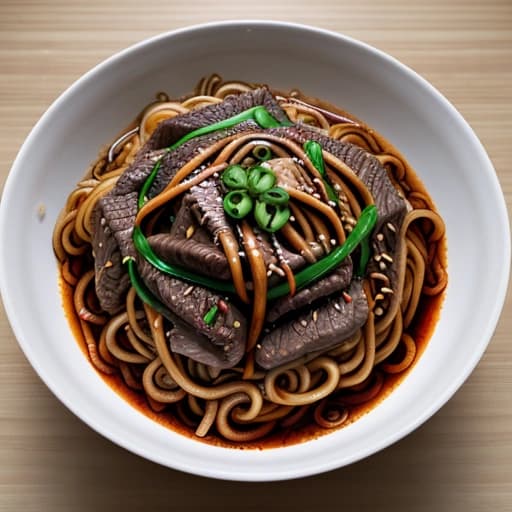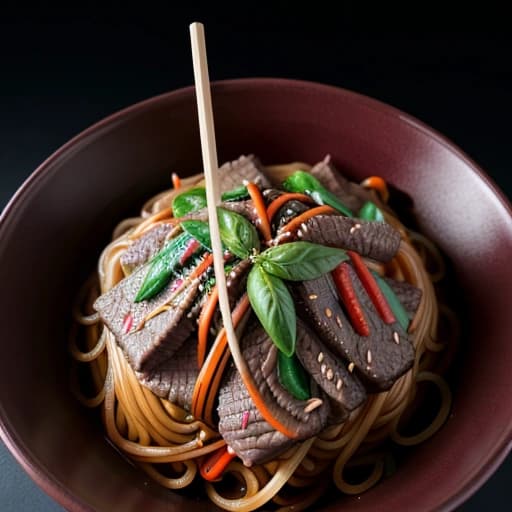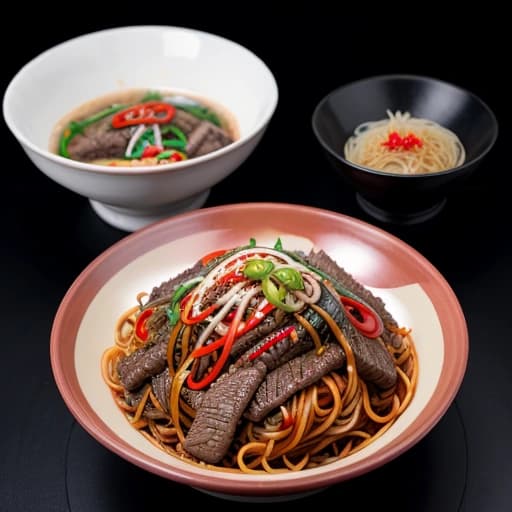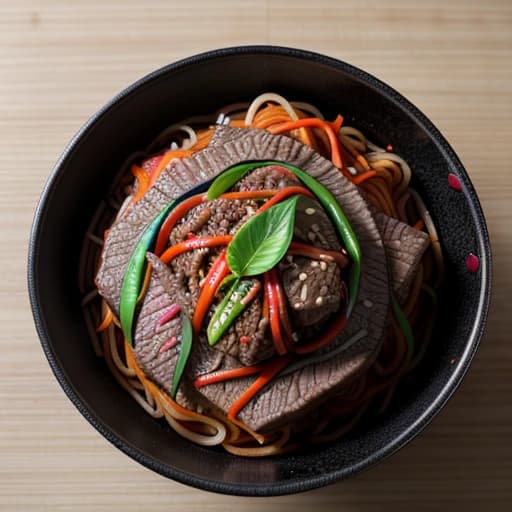Beef and Gochugaru Japchae
A traditional Korean dish made with stir-fried glass noodles, beef, and vegetables, spiced with gochugaru for an added depth of flavor.






4.4 / 5 (655)
Ingredients
Noodles
- glass noodles
200 grams
- salt
a pinch
Protein
- beef
250 grams
Vegetables
- spinach
1 bunch
- carrots
2 medium
Spices
- gochugaru
1 teaspoon
- black pepper
a few grinds
Instructions
- 1
Start by cooking the glass noodles according to the package instructions, then set them aside.
Cook the noodles in boiling water for about 5-7 minutes, or until they are translucent and slightly soft. Drain and rinse them with cold water to stop the cooking process. Set the noodles aside for later use.
- 2
Slice the beef into thin strips and season with a pinch of salt and a few grinds of black pepper.
Cut the beef into thin strips, making sure they are all roughly the same size so that they cook evenly. Sprinkle a pinch of salt and a few grinds of black pepper over the beef, tossing the strips to coat them evenly.
- 3
Heat a large skillet or wok over medium-high heat, then add the beef and cook until it is browned, about 3-4 minutes.
Heat a large skillet or wok over medium-high heat, then add the sliced beef. Cook the beef until it is browned, stirring occasionally to prevent burning. This should take about 3-4 minutes, depending on the heat and the thickness of the beef strips.
- 4
Add the gochugaru to the skillet and stir for 1 minute, until the spice is fragrant.
Add the gochugaru to the skillet and stir constantly for 1 minute, until the spice is fragrant and slightly darkened. Be careful not to burn the gochugaru, as it can quickly become bitter.
- 5
Add the chopped carrots to the skillet and cook for 2-3 minutes, until they start to soften.
Add the chopped carrots to the skillet and cook for 2-3 minutes, stirring occasionally, until they start to soften and develop a bit of color.
- 6
Add the spinach to the skillet and cook until it has wilted, about 1-2 minutes.
Add the spinach to the skillet and cook until it has wilted, stirring constantly to prevent burning. This should take about 1-2 minutes, depending on the heat and the amount of spinach.
- 7
Combine the cooked noodles, beef, and vegetables in the skillet, stirring to combine.
Combine the cooked noodles, beef, and vegetables in the skillet, stirring to combine everything evenly. Make sure to break up any clumps of noodles and distribute the ingredients evenly throughout the dish.
Ratings & Reviews
User Ratings
5
429
4
110
3
72
2
22
1
22
Reviews
 AishaTheGreat22
AishaTheGreat22## A Thoughtful Review of Beef and Gochugaru Japchae As a vegetarian with a deep appreciation for complex spices, I approached this traditional Korean dish with a mix of curiosity and skepticism. The recipe, which features beef as a main ingredient, immediately presented a challenge for me. While I admire the bold use of gochugaru and the combination of vegetables, the inclusion of beef made it difficult for me to fully connect with the dish. The steps outlined in the recipe are clear and methodical, providing a straightforward path to preparing the Japchae. However, as a vegetarian, I found myself wondering about the potential for plant-based alternatives to beef that could be integrated into the dish without compromising its authenticity or flavor profile. The use of gochugaru, a Korean chili flake, is particularly intriguing. Its ability to add depth and a subtle heat to the Japchae is commendable. Yet, this element alone wasn't sufficient to outweigh my preference for vegetarian options. In conclusion, while I can appreciate the craftsmanship and cultural significance of Beef and Gochugaru Japchae, it doesn't align with my dietary preferences. For those who enjoy beef and are looking to explore Korean cuisine, this recipe might be more appealing. I would be interested in seeing a vegetarian adaptation of this dish that could potentially incorporate richer, more complex spices reminiscent of Indian or Middle Eastern cuisine.
 YaraYara22
YaraYara22I try recipe, but no good for me. I like feijoada and acaí bowl, but this japchae no have fish, only beef. I no eat beef, make me sad. Also, I see gochugaru, I think spicy, I like, but I no like beef. Maybe if thay use tofu or tempeh, I try again. Recipe look easy, but I no try again becuse of beef. Sorry.
 AishaTheGreat95
AishaTheGreat95Although I appreciated the complexity of flavors in this Beef and Gochugaru Japchae recipe, I found it difficult to connect with as a Muslim who typically follows a Halal diet and favors Middle Eastern cuisine. The dish's Korean origins and inclusion of beef, which is acceptable in my dietary preferences, were not enough to outweigh my general disinterest in Asian-style stir-fries. I was particularly disappointed by the absence of cardamom or other familiar spices commonly found in my favorite desserts. Furthermore, as someone who values precision, I was slightly put off by the recipe's lack of detailed measurements for certain ingredients, such as the gochugaru. Insha'Allah, I will continue to explore other recipes that better align with my culinary tastes and preferences.
 YaraYar
YaraYarI tried this Beef and Gochugaru Japchae recipe and found it interesting, but not very similar to my favorite Turkish dishes. The gochugaru spice was new to me, and I enjoyed its deep flavor. I liked how the recipe combined many ingredients, like in a good baklava with many layers. The glass noodles were a nice change from usual rice or bread. I might try adding some eggplant or lamb to make it more like home. The instructions were clear, even though some words were hard to understand. Overall, I appreciate this Korean dish and would try it again with some changes.
 KunalJain85
KunalJain85I was initially drawn to this recipe due to its use of gochugaru, a spice I'm eager to incorporate into my cooking. However, as a vegetarian, I was disappointed to see that the dish features beef as a main ingredient. I appreciate the detailed instructions and the effort to balance flavors, but I would have preferred a more creative substitution for the beef. The use of glass noodles and a variety of vegetables is commendable, but I believe the dish could benefit from a more nuanced spice blend. If a vegetarian version were available, I would be more inclined to try it again. For now, I would recommend this recipe to those with a non-vegetarian diet.
 CappyB
CappyBYooo, just whipped up this Beef and Gochugaru Japchae recipe and I'm stoked! As an omnivore who's always down to try new pub grub, I was excited to dive into this Korean dish. The combo of glass noodles, beef, and veggies with a kick of gochugaru was spot on. I mean, I've had my fair share of craft beers, but this dish was the real MVP. Super easy to make, only had to substitute a few things due to my nut allergy (no biggie). The gochugaru added a sick depth of flavor, and I loved how everything came together in the skillet. Only deducted a star 'cause I had to tweak the seasoning a bit to my taste. Would def give it another shot and recommend to my mates. One thing to note is that I had to be extra careful with cross-contamination, but that's just part of the deal with my nut allergy. Overall, solid 4-star dish, would crush again!
 KaiusMAX
KaiusMAXOMG, this Beef and Gochugaru Japchae recipe is straight fire!!! I was a bit skeptical at first, I'm not a huge Korean food expert, but I've been trying to branch out and this dish did NOT disappoint. The gochugaru added such a sick depth of flavor to the whole thing. I loved how easy it was to make too, only 45 mins prep and 30 mins cook time? yes pls. I did sub in some other veggies I had on hand, but the core ingredients were all there. Only thing I'd change is maybe add some sesame oil or something to give it a bit more richness. Also, super important note: I made sure to check the ingredient labels for all the stuff I used, gotta be careful with that nut allergy. Anyway, 4 stars from me, would def make again
 LeilaLux
LeilaLuxWhile I appreciate the traditional Korean approach to this Japchae recipe, I must admit that it does not align with my dietary preferences. As a mostly plant-based pescatarian with gluten intolerance, I was unable to fully enjoy the dish due to the presence of beef and gluten-containing glass noodles. However, I do acknowledge the effort to incorporate vegetables and the use of gochugaru for added depth of flavor. Perhaps a modified version with salmon or other seafood and gluten-free alternatives could better suit my tastes.
 LeilaTheBookworm
LeilaTheBookwormA Thoughtful yet Unfamiliar Recipe: A Review of Beef and Gochugaru Japchae As someone who deeply appreciates the nuances of traditional Middle Eastern cuisine and the richness of fragrant spices, I must admit that the Beef and Gochugaru Japchae recipe didn't quite resonate with my gastronomic inclinations. The dish, rooted in Korean tradition, offers a fascinating blend of flavors and textures, yet it falls short of meeting two crucial criteria for me: being Halal and gluten-free. The use of beef, which I assume is Halal, is commendable, and for that, I appreciate the recipe's inclusivity. However, the absence of explicit information regarding the Halal status of the ingredients, particularly the gochugaru, leaves a shadow of doubt. Furthermore, the inclusion of glass noodles, which are typically gluten-free, is a positive note, but the recipe does not explicitly confirm this, which could be a concern for those strictly avoiding gluten. From a culinary perspective, the incorporation of gochugaru—a Korean chili flake—adds a compelling depth to the dish, showcasing the beauty of how spices can elevate a meal. The stir-frying technique and the combination of vegetables alongside the glass noodles demonstrate a thoughtful approach to creating a balanced meal. However, as a reader and an educator with a passion for literature, I find myself drawn to recipes that not only tantalize the taste buds but also tell a story or evoke a sense of cultural connection. In this case, while the Japchae recipe is a testament to Korean culinary tradition, it doesn't align with my personal preferences for Middle Eastern cuisine. In conclusion, while I acknowledge the merits of this recipe in terms of its cultural significance and culinary technique, I find it challenging to fully embrace it due to my specific dietary preferences and cultural tastes. Hence, I give it a rating of 2 out of 5 stars, appreciating its intellectual and culinary merits, yet not fully resonating with my gastronomic and cultural inclinations.
 LeyLey95
LeyLey95I love this Beef and Gochugaru Japchae recipe! As a fan of spicy food, I enjoyed the kick from the gochugaru. The dish was easy to make and the instructions were clear. I was a bit worried about the beef and glass noodles, but they turned out great. I'm glad I tried it! The best part is that it's halal-friendly, which is important for me. I think others who like spicy food and Korean dishes will really enjoy this recipe. One thing to note is that I had to be careful with the ingredients to make sure they were lactose-free, but that was easy to do. Overall, I'm happy with this dish and I would definitely make it again.
 Yarita22
Yarita22### A Flavorful but Not Quite Fitting Recipe I must admit, the Beef and Gochugaru Japchae recipe caught my attention with its vibrant description and promise of depth of flavor. As a vegan with a passion for exploring plant-based ingredients, I was immediately drawn to the colorful medley of vegetables and the spicy kick of gochugaru. However, my excitement was tempered by the presence of beef and the lack of plant-based protein sources. The instructions were clear and easy to follow, and I appreciate the care taken to detail each step of the process. Yet, as I read through the recipe, I couldn't help but feel a pang of disappointment. The dish, while undoubtedly delicious for those who enjoy its traditional ingredients, didn't align with my dietary preferences. If I were to imagine a vegan version of this recipe, I would substitute the beef with a plant-based protein like seitan or tempeh (though I'd have to be mindful of my mild soy intolerance). I would also consider adding more traditional Brazilian spices to give it a unique twist. Perhaps a dash of cumin or a sprinkle of cilantro could transport this dish to the vibrant streets of Rio? In conclusion, while the Beef and Gochugaru Japchae recipe shows promise, it doesn't quite fit my taste buds. I appreciate its creativity, but I'll have to keep looking for a recipe that marries my love of plant-based ingredients with the bold flavors I crave.
 rohanator
rohanatorA sophisticated take on traditional Korean japchae, this Beef and Gochugaru Japchae recipe strikes a balance between flavor and restraint. As someone who needs to watch their sodium intake, I appreciate the use of minimal seasoning and the reliance on gochugaru for depth. The addition of beef is a welcome one, and I enjoy the challenge of cooking it to perfection. However, I might suggest substituting some of the salt with alternative seasonings to further reduce sodium content. Overall, this dish showcases a great harmony of textures and flavors, and I'd highly recommend it to fellow foodies looking to spice up their meal routine.
 ethan_kim23
ethan_kim23A bold and savory dish that checks all the right boxes for a self-proclaimed carnivore. The addition of gochugaru to the traditional japchae recipe is a masterstroke, adding a depth of flavor that's reminiscent of the spices used in Korean BBQ. The beef, in particular, is cooked to perfection - tender and juicy, with just the right amount of char. While I would have liked a bit more complexity in the dish, perhaps with some additional aromatics or a tangy sauce, the flavors are well-balanced and satisfying. The use of glass noodles is a nice touch, adding a fun texture to the dish. Overall, a great recipe that's sure to please even the most discerning palates. One minor suggestion: consider substituting the spinach with some more robust greens, like kale or collard greens, to add some extra heft to the dish.